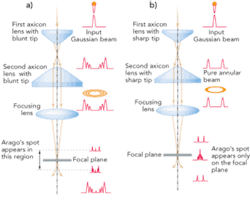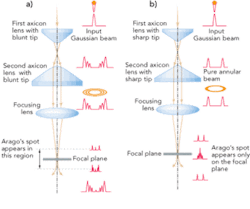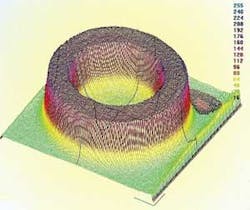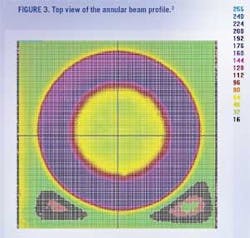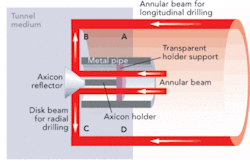A New Method of laser drilling
Aravinda Kar and William P. Latham
An optical trepanning system has demonstrated the ability to rapidly drill high-quality holes
Laser drilling can be classified into three categories: percussion drilling, mechanical trepanning, and optical trepanning. Percussion drilling uses pulsed lasers with laser spot size approximately equal to the diameter of the hole. Mechanical trepanning utilizes a tiny focused laser spot of diameter much smaller than the diameter of the hole. The tiny spot is then scanned along a circular or spiral orbit relative to the workpiece to cut a hole of desired shape. The trajectory of the spot is generally maintained by rotating an optical device, the laser-focusing lens, or the workpiece. Optical trepanning, on the other hand, is accomplished with a stationary annular beam, which is focused onto the workpiece to induce heating, melting, and vaporization around the periphery of the annulus to drill holes with less wasted energy.
The drilling speed can be increased in any of these drilling techniques using an assist gas to remove the molten material or to induce metal burning. A critical step in optical trepanning is to transform the Gaussian or multimode laser beam of a typical laser system into an annular beam. Various beam-shaping optics1 are available to obtain annular beams, and such optics are designed using geometrical or diffraction theory of light propagation.2,3 Laser beam shaping involves redistribution of laser irradiance, as well as modification of the geometrical shape of the laser-beam cross section. The irradiance distribution defines the beam profile, such as Gaussian, multimode, annular, rectangular, elliptical, or circular.
Beam-shaping optics and diffraction
Axicon optics have been shown to generate intense nondiffracting beams, 4-7 generally known as the Bessel beams, whose irradiance pattern in the transverse plane does not change over a large distance as the beam propagates in free space. The central diffraction pattern of such beams, that is, the diameter of the laser spot, can be very small (several wavelengths) with an infinite depth of field, which is important for applications such as optical imaging, laser metrology, dispersionless optical system design, and the production of plasma waveguides.
The axicon optical system, which forms the annulus, must be designed to minimize the diffractive effects and to allow for optical fabrication errors. Optical aberrations in the optics due to imprecise manufacturing processes lead to the formation of imperfect annular beams, and the diffraction by the focusing lens alters the irradiance profile along the beam propagation path (see Fig. 1). Due to the presence of multiple diffraction rings in imperfect annular beams, the spot of Arago exists over a certain axial length around the focal point although the theory predicts the presence of Arago’s spot only on the focal plane. Another implication of poorly designed or aberrated optics is that an imperfect annular beam, that is, an annulus with multiple diffraction rings, reappears after the focal plane in the experimental results. On the other hand, a perfect annular beam appears in the theoretical result due to a perfect annular beam incident on the focusing lens.
When the diffractive effects are minimized, optical trepanning allows flexibility in improving the hole quality, decreasing the loss of laser energy due to conduction in the workpiece, and increasing the drilling speed compared to the traditional circular-beam laser drilling, because the laser energy can be supplied to the workpiece with an annular beam in a variety of ways. Also, optical trepanning is simpler than mechanical trepanning because it utilizes optics to accomplish the creation of the annular beam, so that there are no moving parts.
The irradiance profiles are usually Gaussian, or uniform, in percussion drilling and mechanical trepanning processes. For optical trepanning, however, the irradiance profile can be Gaussian, half Gaussian, uniform, or designed for any other shape in the annular region. Half-Gaussian beams with maximum intensities at the inner and outer radii of the annulus, which will be referred to as inner half Gaussian and outer half Gaussian, respectively, can be used advantageously to achieve better drilling efficiency due to reduced thermal effects in the materials compared with full Gaussian beams with maximum intensity within the annulus.
Applications of optical trepanning
Deeper melt depths are produced with an outer half-Gaussian annular beam than with the inner half-Gaussian and full-Gaussian beams for both uniform and triangular pulse shapes. The outer half-Gaussian beams generate the maximum temperature at the outer circumference of the annulus, allowing heat conduction from there toward the center of the annulus leading to deeper melt depth. The inner half-Gaussian beam, on the other hand, generates the maximum temperature at the inner circumference of the annulus, and, therefore, some of the thermal energy is conducted toward the outer circumference away from the central region.
The full-Gaussian annular beam produces smaller melt depths because it generates the maximum temperature inside the annular region and, therefore, the heat is conducted toward both sides (inner and outer circumferences) of the annular region. Thus, heat conduction occurs more in the radial direction than along the thickness of the workpiece in the case of full-Gaussian beams.
Optical trepanning also enables the modification of the hole taper geometry. For example, convergent or divergent holes, which are generally important in fuel-injection nozzles, can be readily drilled using different irradiance profiles. Axicon lenses of different conic surfaces can produce annular beams having various irradiance profiles. Such profiles can also be utilized to tailor the recast layer thickness and the heat-affected zone (see Figs. 2 and 3).
Optical trepanning provides a novel way of supplying energy to the workpiece along the circumference of the annular beam and thereby enables large-area drilling without melting and/or vaporizing the entire material in the volume of the hole. This mechanism can be used to drill large-diameter holes or cut large openings in metals, concrete structures, or walls. It can also be utilized for tunnel digging, mining, and oil exploration (see Fig. 4).
Besides drilling, the annular beams are of considerable interest for other applications such as laser cooling and trapping of neutral atoms8 and circular incision as well as circular heating in biomedical procedures. Large depth of focus, that is, maintaining constant laser irradiance over a large distance, is important in all applications, including drilling.
Professor Aravinda Kar is with the Laser-Aided Manufacturing, Materials and Micro-processing Laboratory, College of Optics and Photonics, Center for Research and Education in Optics and Lasers, Mechanical, Materials and Aerospace Engineering Department, University of Central Florida, Orlando, FL, USA. Dr. William P. Latham is with the Air Force Research Laboratory, Directed Energy Directorate, Kirtland Air Force Base, NM, USA.
References
- W. Spawr, "Beam-shaping improves processing," Industrial Laser Solutions, p. 15 (December 1999).
- D. Zeng, W. P. Latham, and A. Kar, "Characteristic analysis of a refractive axicon system for optical trepanning," Optical Engineering 45, p. 094302-1 (2006).
- D. Zeng, W. P. Latham, and A. Kar, "Shaping of annular laser intensity profiles and their thermal effects for optical trepanning," Optical Engineering 45, 1, p. 14301-1 (2006).
- V. Garces-Chavez et al., "Simultaneous micromanipulation in multiple planes using a self- reconstructing light beam," Nature 419, p.145 (2002).
- R. M. Herman and T. A. Wiggins, “Production and uses of diffractionless beams,” J. Opt. Soc. Am. A, 8, p. 932 (1991).
- J. Durnin, “Exact solutions for nondiffracting beams. I. The scalar theory,” J. Opt. Soc. Am. A, 4, p. 651 (1987).
- J. Durnin, J. J. Meceli, and J.H. Eberly, “Diffraction-free beams,” Phys. Rev. Lett. 58, p. 1499 (1987).
- I. Manek, Y. B. Ovchinnikov, and R. Grimm, "Generation of a hollow laser beam for atom trapping using an axcion," Optics Communications 147, p. 67 (1998).
